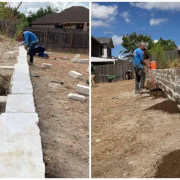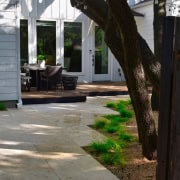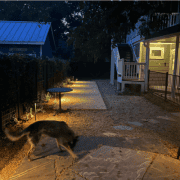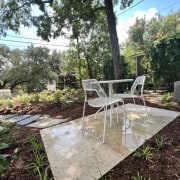Solving Balmorhea’s Bewildering, Buried Irrigation Puzzle
Maintenance staff at Balmorhea State Park were hunting a subterranean ghost.
A 12-zone irrigation system that covered thousands of square feet snaked below most of the distinctive West Texas property. As designed, it sent water to the park’s wide network of plant life and multi-use areas, from ocotillo and cottonwood to sprawling grass picnic lawns.
The extensive system utilized equipment and piping on a scale that rivaled a typical golf course. But unknown causes were keeping it from fulfilling its intended outcomes.
 Balmorhea State Park, home to the world’s largest spring-fed swimming pool. Photo: Wiki Commons
Balmorhea State Park, home to the world’s largest spring-fed swimming pool. Photo: Wiki CommonsPark Superintendent Torrey Bonham was hard at work diagnosing the problem but found details hard to come by.
“It was put in many years ago and as previous superintendents retired, a lot of the knowledge was lost. That’s why we were struggling to rectify the issues,” Bonham said.
Balmorhea’s Background
The need to get the job done was obvious. Balmorhea State Park lies in a particularly scorching pocket of West Texas. The San Salomon Springs, which now feed the pool, used to naturally irrigate the area with a system of streams and cienegas. But when the Civilian Conservation Corps constructed the pool in the 1930s, it re-channeled the natural water source. The diversion essentially made irrigation a necessity for the native and adapted species around the park.
Not to mention the grass. By 2022, the soft grass beds that covered the lawns where visitors picnicked and relaxed were dying under the scorching West Texas heat.
The State Park is an unequivocal gem. It attracts a diverse array of visitors from all over the country, and draws important tourist funding into the local economy. It’s also a safe haven for a wide range of wildlife, from birds like the Great Blue Heron and the American Coot to pupfish and softshell turtles.

Bonham worked to settle the issue, fast.
Urgent Scope Leads the Way
Maas Verde irrigation techs not only accepted the challenging assignment of an extensive diagnostic and repair at the park, but began the scope with one urgent line item.
A Texas nonprofit had planted several trees alongside the pool’s central walkway, in anticipation of an upcoming fundraiser. The donated plantings, installed in cooperation with the State Park, were now withering in the desert soil without water. There was a week to go until the event.
Maas Verde mobilized from its Austin headquarters with its best irrigation technicians and no time to spare.
An expedited diagnostic revealed several problems that stemmed from work by previous contractors. First, workers who had planted the trees had evidently cut buried pipes and made no effort to repair them.
A different company began another scope of work by replacing the system controller — but replaced it with a unit that was below commercial grade. Next, they installed around 100 feet of light-duty PVC, which led to a junction near the new trees and a few failed bubbler heads.
That was as far as Maas Verde traced their progress. The work was incompatible with the existing system, but also buried squarely in the way of any remediation.

Beyond these functional issues, the system’s original design was an enigma.
Troubleshooting and Repairs
Maas Verde president and founder Ted Maas led the company’s first, ambitious mobilization to the site. A seasoned landscape technician with Master Irrigator course experience, Maas understood right away that his team was facing a perplexing task.
“Immediately I realize, there is so much going on with this system that none of us can know. We’re trying to get an idea of what this thing looks like underground. I’m getting information from multiple channels, and some of it’s conflicting,” Maas explained.
As Bonham worked to organize information and reconcile reports, Maas Verde blitzed the priority list. The company first made a plan to irrigate the struggling new trees. Running a new zone that bypassed the various damaged and partially functional components would be the best practice.

Sourcing compatible-sized PVC and valves from Odessa (a 90-minute drive away), the team got to work. Tasks included trenching to spec, boring underneath a concrete sidewalk, checking connections, and completing the new zone with componentry.
Maas Verde logged overtime each day to complete the project on schedule, to a satisfactory result.
But that was just the beginning.
Several months of periodic visits ensued, as the team worked to make sense of the rest of the system and trace underground faults. The faults seemed to multiply; because the technicians could only locate the next electrical failure or pipe leak by tracing it downstream from the last one, the work required diligence and patience.

Criss-crossing components representing years of layering work made diagnostics and repairs more puzzling. A contractor had inexplicably cut wires and buried them inches outside a valve box, but connected the wrong wires inside; A heavy equipment operator had destroyed several feet of pipe with an excavator but buried it without a trace; miswired solenoids had shorted out and no longer operated.
Eureka! System Finally Works
Maas Verde worked methodically. Finally, technicians excavated an old valve buried in an obscure location below several inches of natural turf. It proved to be the last missing link in the system. The team incorporated it into the system, confirmed each zone operated from the controller, and concluded the project.
View this post on Instagram
Prior to Maas Verde’s involvement, one other contractor had made marginal progress. That company repaired a few mainline breaks and diagnosed some non-communicating solenoids, but fell short of the full repair.
Once Texas Parks and Wildlife awarded a contract to Maas Verde, Bonham had added the last phone number to his list on the project.
Bonham complimented Mass on their “attention to detail, and willingness to get it done. When we ran into zones not working and so forth, it was really Maas Verde’s commitment to staying behind its word that set it apart and ultimately got the job done.”

 A Mexican sycamore (Platanus mexicana) in two stages of dormancy. Photos were taken approx. one month apart.
A Mexican sycamore (Platanus mexicana) in two stages of dormancy. Photos were taken approx. one month apart.











 Photo: Sadie-Michaela Harris, WordPress
Photo: Sadie-Michaela Harris, WordPress Life finds a way. See the green?
Life finds a way. See the green? Dappled shade and tall enough grass is a recipe for success.
Dappled shade and tall enough grass is a recipe for success. Tall blades do better even in poor soil.
Tall blades do better even in poor soil. Thatch layers promote nutrient cycling, helping grass survive even the driest months.
Thatch layers promote nutrient cycling, helping grass survive even the driest months.






















